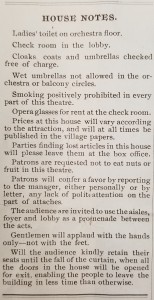SMITH HISTORY BLOG: House Rules / House Notes
By Austin Jennings
It can be particularly fun to look back at old cultural rules, which can often be passing fads or signs of the technology of the time. Comparing those old rules to those of today can surprise us in how far we’ve come or how little we’ve changed. So, to have some of that fun, here is a look at some of the original house notes and rules of the Smith Opera House. In comparing them to the Smith today, we’ve created a list of the Top 3 Similarities and Top 3 Differences between them and the Smith’s house rules today.
Top 3 Similarities:

Here are the house notes which appeared in the program for the opening performance of the Smith, Monte Cristo, on October 29, 1894. Courtesy of the Geneva Historical Society.
- “Ladies’ toilet on orchestra floor,” (Monte Cristo).
This 1894 note technically remains true today, though it hasn’t always been that way. After Schine Enterprises completed renovations to the Smith in 1931, restrooms only existed on the second and basement floors. Thankfully this changed in the early 1990s when the Finger Lakes Regional Arts Council made renovations to create first-floor handicap-accessible restrooms (“Handicapped Access Enhanced at the Smith”)
2.“Smoking positively prohibited in every part of this theatre,” (Monte Cristo).
Even though we remember public smoking as far more acceptable back in the day, it was still completely unacceptable in the theatre. Today’s house rules note that “New York State bans smoking in all public buildings. There is no smoking in The Smith. This includes e-cigarettes and vaporizers. Patrons caught smoking will be asked to leave the building,” (“Box Office Policies and House Rules”). It seems like no smoking rules haven’t become any less strict in the past 125 years.
3. “The audience are invited to use the aisles, foyer and lobby as a promenade between the acts,” (Monte Cristo).
It’s almost comical that such a note had to be written, as it’s a given today that audience members are allowed to walk around during an intermission. Nothing has changed, except that this practice has become so normal that we no longer have to add it to our house rules.
Top 3 Differences:
- “Telephone and messenger call-boxes in the manager’s office,” (La Mascotte)
A sign of the times, this note from 1903 directly contrasts today’s world where none of us need a telephone in the manager’s office. We all have phones in our pockets. Of course, this change in technology has necessitated the modern Smith House Rule, “all cell phones and electronic devices must be silenced or turned off during all movies and live performances. If you need to make or take a call, please do so in our lobby or foyer,” (“Box Office Policies and House Rules”).
2. “Gentlemen will applaud with the hands only–not the feet,” (Monte Cristo).
These days it would be very odd for us to applaud by stomping after witnessing a particularly moving Shakespeare soliloquy. If this form of appraisal were to become trendy once again, however, the Smith understandably may have to reinstate this rule
3. “Opera glasses for rent at the check room,” (Monte Cristo).
While the Smith no longer provides opera glasses for rent, “we do have audio devices to loan out for movies and live events, with the choice of earphones or induction loop,” (“Box Office Policies and House Rules”).
Works Cited
“Box Office Policies and House Rules.” Smith Center for the Arts, 2018. https://thesmith.org/contact-us/box-office-information/
“Handicapped Access Enhanced at the Smith.” Press release, circa 1993. The Smith Opera House archives.
“House Notes.” Monte Cristo, program, Smith’s Opera House, 29 Oct 1894, pp. 2. Geneva Historical Society archives, collection 78, box 1, folder 11.
“House Notes.” La Mascotte, program, Smith’s Opera House, 23 Feb 1903, pp. 2. Geneva Historical Society archives, collection 78, box 1, folder 3.